Update:
RimWorld - Biotech is out now! RimWorld’s third expansion,
RimWorld - Biotech is coming out in a few weeks!
We’re also making the free base game 1.4 update available now for play on the unstable Steam branch. More details about that near the bottom of this post.
EDIT: To be clear, the unstable branch only has base game content. Biotech is coming out soon, but isn't available yet.This post will:
- Describe Biotech's features
- Present Tynan’s thoughts on why he decided to make Biotech as it is
- Go over new features in the free 1.4 update
You can
wishlist RimWorld - Biotech now!
About Biotech
Biotech is focused around three major features:
- Control mechanoids, including many new mechanoid types, by making your colonist into a mechanitor
- Raise babies and children. Reproduce and create families - by both natural and artificial means
- Genetically-modify children and adults, and interact with new gene-modded factions
Children and reproduction Now you can raise a family and tell your story for generations to come!
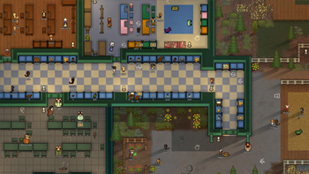
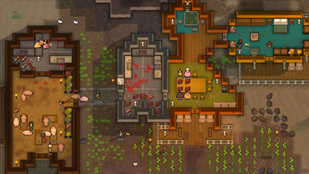
With
Biotech, colonists (and outsiders) can become pregnant and give birth. Pregnancy can begin naturally, or via technological means, and can be controlled by a variety of methods.
Babies bring joy, but also challenges. Colonists’ hearts will melt when the baby coos and giggles in their arms. But it takes effort to keep a baby happy and healthy and loved - create a safe haven for them in a cozy pastel nursery where there is always warm milk, a comfortable crib, overflowing toy chests and kind caregivers.
They grow up fast (especially if you use a growth vat) - soon your child will be walking, talking, and getting into trouble. They’ll soak up knowledge in the classroom and tag along with adults to watch them work. Kids find many ways to entertain themselves with art, exploring nature, playing with technology, and more. Teach them lessons and they’ll learn how to survive, cook, make friends, create art, build, craft, hunt, and fight. Watch as they grow up and make mistakes, lose loved ones, and survive hardships.
A rich childhood makes a capable adult. Every few years, you choose which traits and passions a child will develop. The better-raised a child is, with smarter education and more attention, the more choices you’ll have, and the better their chances are to become a happy and talented adult. Some colonies will sacrifice everything to give a child the best upbringing, while others will use growth vats to pump out cheap workers and soldiers. The choice is up to you.
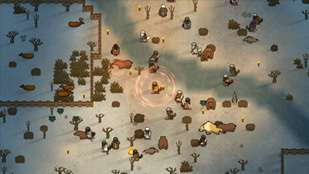

The mechanitor Build and control mechanoids by making your colonist into a mechanitor - a person with a special brain implant that lets them psychically command semi-living machines.
Create mechanoids by growing them inside high-tech gestator tanks. Command the original centipede, lancer, and scyther, plus a wide variety of new combat and labor mechanoids. Grow your swarm from a few small workers and fighters to a fearsome squadron of massive ultratech war machines and industrial behemoths.

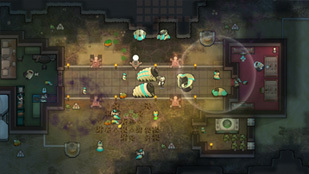
Mechanoid laborers can manufacture goods, rescue and tend to your colonists, build and repair structures, sow and harvest crops, haul stuff, and more. They never get sick. They don’t freeze in the snow or get poisoned in toxic fallout. They don’t suffer mental breaks from long hours in dark mineshafts or filthy garbage yards.
Combat mechanoids are very diverse in form and function. Some are cheap swarmers that overwhelm the enemy with numbers. Others project shields over their allies, or roast enemies with beam weapons, or charge up for massive concrete-melting hellsphere attacks. Mechanoids wield melee claws and blades, sniper weapons, even flamethrowers. Depending on which mechanoids you command, your tactical options will vary dramatically.
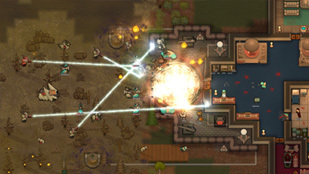
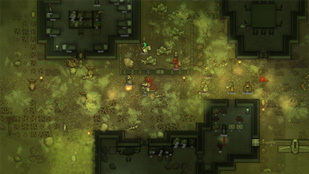
Mechanoid infrastructure has a special price: Pollution. Left unfrozen, toxic wastepacks deteriorate and leak pollutants into the environment. Pollution makes living things sick. It poisons your colonists and pets. It blocks the sunlight with smog and irritates your colonists’ lungs. It triggers hibernating insects to emerge on the planet’s surface. Some areas of the planet are so polluted that only twisted, toxin-adapted variants of plants and animals can survive there. Pollution is a challenge that you can handle in a variety of ways - freezing, export (neighbors might not like this), adaptation, high-tech atomization.
Advance your mechanitor’s capabilities by acquiring ancient mechanoid technology. This means calling dangerous new super-mechanoids to attack, in order to defeat them and steal technology from their smoking corpses. There are three types of hyper-deadly commander mechs to fight, each with its own weapons and combat style. Be sure you’re ready before you call these machine beasts to attack. Learn enough, and some day, you may command them as your own.

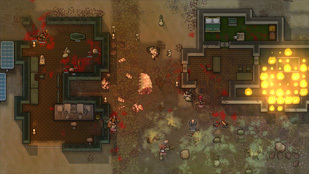
Gene modding You can genetically-modify people to create xenohumans - humans with exotic traits. Genetic modifications range from subtle personality traits and eye color to hulking furry bodies, glands for fire-breathing, rapid regeneration, and even immortality.
The world contains a new set of xenohuman types and factions, including unstoppable super soldiers, fur-covered animal-controlling arctic settlers, toxin-immune human bioweapons, fire-breathing horned desert imp-people, psychic-bonding concubines, and more. The darkest of them drink blood and live in shadows, deathless for eternity.
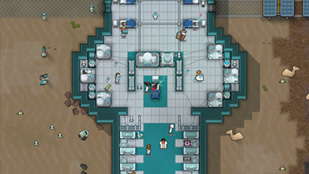
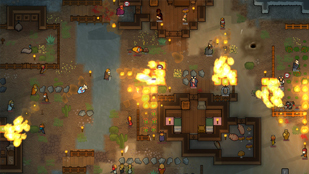
You can make your own xenotypes from scratch, and build infrastructure in your colony to enhance your people. Curate a collection of exotic genes by purchasing them from traders, accepting them as quest rewards, or extracting them from your menagerie of xenohuman prisoners. You can harvest the genes from anyone and implant those genes into your colonists and prisoners. You can also recombine genes to make bizarre and advantageous mixes of traits for implantation. Experiment with gene extraction and recombination to build your colony of xenohumans!
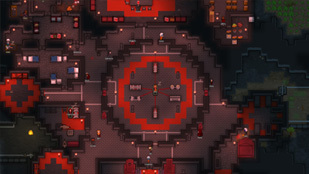
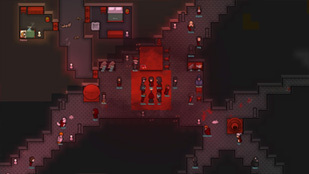
Why Biotech? Hey everyone - Tynan here. I thought it would be worth explaining the thought process behind why we decided to make this expansion. Here’s what I’ve been thinking:
Why mechanitors? Mechanoids have been RimWorld’s end-game foes since way back in 2014. Fictionally, however, they are human-created for human purposes, so it was natural to extend this and allow the player to control the mechanoids somehow.
Since RimWorld is a character-oriented story generator, I didn’t want to just add the mechanoids as independently-controlled robots the player can order around like an RTS. This would have been moving away from the character-orientation that defines RimWorld. The mechanoids needed to be human-connected.
That’s why I designed a system where each mechanoid is linked to a specific person, the mechanitor. The mechanoids are an extension of the human who controls them, with all the human complexity that entails.
I also didn’t want to destroy the economic balance or progression rate of mechanoids. This would have been easy to do. Human beings are inherently quite expensive - they need complex foods, decent living quarters, social relationships, entertainment, even rituals with the Ideology expansion. In a naive game design, a colony of mechanoids could skip most of these needs and be absurdly overpowered - fun for a short time but ultimately uninteresting.
Making the mechanoids human-linked alleviated part of this concern, but they needed another cost since they are inherently so much less needy than people. Just eating resources wouldn’t feel novel or interesting enough, so we needed a new kind of cost. I decided to explore the concept of pollution. Pollution doesn’t cost anything to make, but it incurs challenges that come afterwards. It’s a bit like going into debt - not a problem at first, but if you let it catch up to you, it soon becomes a transformative challenge. We made sure there are a variety of ways to approach pollution, so players can choose whether to try to stay clean, suppress the effects, or just let it happen and adapt to the changing landscape. This linked in nicely with the gene modding system as well, since some genes help with pollution resistance.
Pollution itself is designed to be interesting - it interacts with the insects, generating them and powering them up. It transforms the landscape visually and economically, replacing normal plants and animals with a new set of pollution-specific plants and creatures. The new polux tree is a natural way to alleviate pollution. It’s livable, but there are special challenges to living in pollution.
Finally, player-controlled mechanoids were going to open up new ways to do combat. In the past, the player’s units were limited in how diverse they could be since they were mostly humans. Mechanoids can have much more exotic types of movement, weaponry, and combat tools. They can also be more expendable than humans. All this opened up opportunities for more types of player-side combat strategies, which we’ve explored in depth with new types of combat mechanoids. It gives the player more tactical choices in combat, and more ways to be aggressive instead of risk-avoidant.
The naturalness of fiction, human-connectedness, unique new costs and strategies together made player-controlled mechanoids a really attractive design path. It took a lot of work to build all that but we had the time and resources to do it right.
Why reproduction and children? The core design goal of RimWorld is to generate emotionally-compelling human stories.
This has always been a challenge when designing a game, because games tend to be very impersonal. In games, progress often focuses on economic gains, increases in power, or expansion of map control. These sorts of numbers-oriented systems work great for games because they’re predictable and mechanistic, which means players can reason about them strategically, and computers can simulate them.
The problem is that a good story isn’t just a sequence of changes in economic numbers, damage amounts, or map control markings. Good stories are about people, emotions, and relationships. Good stories take things that individual humans value - safety, family, love - and put these things up for grabs, and let the character struggle to gain them, or avoid losing them. There must be a relatable person at the center of the story, who is experiencing strong and relatable emotions about something they value.
Which are some of the strongest and most relatable emotions? Those that come from family relationships.
They’re powerful because family is important to us. They’re relatable because everyone has a family, so everyone can empathize with what it might be like to help a brother or parent, have a child, help them, or fear losing them.
This is, of course, obvious, and that’s why other narrative media have explored this topic for thousands of years. Family-linked drama is the bread and butter of stories across older media. From the most classic novels of high culture to the bawdiest barroom tales, questions of family obligation, sacrifice, life and death, and relationships are central to our most compelling stories. From “No, I am your father,” to “I will find you and I will kill you,” to “You are the father,” family relationships are at the center of story. This is true in the western stories that RimWorld is inspired by as well.
Extending that into RimWorld makes obvious sense and it’s something I’ve always been interested in. However, it took a long time to get here because these are such complex topics. Reproduction, birth, baby care and child raising all have a lot of fine details and rich content that I always knew would take substantial effort to get right. I wanted to make sure we had the development power to make the game generate these kinds of powerful family-oriented emotions without cutting corners or excessive jank.
Biotech being the longest expansion development cycle, with the most developers we’ve ever had, I decided that it was time to bite off this big challenge.
Why gene modding? Genetically-modified xenohumans have always been part of the RimWorld universe fiction. They are RimWorld’s way to explore how biologically-different humanoids might tell new stories or unlock new types of gameplay. With reproduction already being part of this expansion, it was natural to extend that into allowing genetic modification.
Like everything else in RimWorld, gene-modding is an inherently character-oriented system. It changes who people are and what they can do, which alters their relationships and the emotions those will produce. It also opens up new gameplay paths - genes can unlock new combat tactics, economic roles, and so on. It gives individuals more distinct visual identities. It even generates new moral choices, as players decide what kinds of modifications they are willing to apply to their people, their children, or their prisoners.
It added more variation to the human world, in the form of different types of factions. Instead of just different human factions with different diplomatic orientations, now those different factions are dominated by different types of xenohumans. This alters how they fight, which makes combats more distinct from each other. Fighting a raid of furred yttakin warriors is quite different from a raid of baseliner humans, or neanderthals, or fire-breathing impids, or pigskins. There’s a lot of fun colorful differences between them too - a raid of squealing pig people feels quite different from a raid of bear-calling furred yttakin.
We experimented with a lot of gene effects before settling on a set that is diverse and consistently fun to play with without breaking the game. It took a while, but in the end testers are loving it.
(I also had a ton of fun writing the name generators for the new xenohuman factions - especially the pigskins. Polork!)
Update 1.4 Update 1.4 is available now on the Steam unstable branch for public beta testing, and to give modders more time to update before release. (The main branch that most people play is unaffected and still on version 1.3 for now).
If you’d like to try 1.4, you can play on the Steam branch unstable. (To get access, go to your Steam library, right-click RimWorld and select "Properties", then select the BETAS tab and choose branch unstable. Restart Steam if your game does not automatically update.)
See info on key features below (changelog at the end):
Startup performance improvements: We spent months optimizing launch and game loading times. In our tests launching RimWorld and loading savegames are roughly 37% faster! On an example system, that’s a startup time improvement from 33 to 21 seconds. Loading a fresh savegame dropped from 7.9 to 4.6 seconds.
Painting and color customization for walls, floors, furniture, and lights: Give your colony a custom look by painting the walls, floors, and furniture of your settlement any of a huge variety of colors using dye harvested from the tinctoria crop. Install a range of new colored carpets in your colonists’ living spaces. Set the mood with lamps that you can set to any color to create your romantic rouge bedroom or an eerie fluorescent laboratory. We expect screenshots to get even more wild thanks to this.
Styles always available: You can now use all styles of all buildings, items, and floors and visually customize your colony even without Ideology active.
Actually useful shelves that store lots of stuff: Fill your storerooms with shelves, which can now hold up to 3 stacks of most items. (Our testers were very excited with this one!) There is also a 1-tile mini-shelf. Shelves should help to keep your colony tidy and organized, and protect your items.
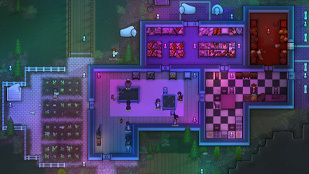
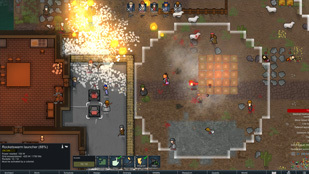 Two new turret types:
Two new turret types: We added two new turret types. The foam turret spits firefoam to extinguish nearby blazes. The rocketswarm turret is a defensive launcher - when triggered, it blankets a wide area in a barrage of small missiles. It is excellent against large groups of weaker enemies, but only works when you press the button, for extra drama!
Starting possessions: Depending on backstory, your starting colonists might come with their own possessions! Not only does it make it a bit easier to start with imperfect colonists, it also gives them a personal touch.
Rot stink: Keep rotten corpses and meat away from your colonists. In addition to being disturbing to look at, decomposing tissue now releases rot stink gas. Colonists that are chronically exposed to rot stink may develop the new “lung rot” disease. Keep extra empty graves and garbage dumps available for times when you’re overwhelmed with bodies!
More prisoners to trade, release, and interact with: In addition to all the prisoners you got before, now you’ll get a new class of prisoner who is unwaveringly loyal to their home. They can’t be recruited, but they can be sold, sent home for diplomatic benefits, used for gene extraction or blood farming in
Biotech, or used in rituals and enslaved in
Ideology. We did it this way because we wanted to make all the uses for prisoners besides recruitment more viable. Adding a new stream of unwaveringly loyal prisoners does that without destroying the population progression balance. They can be disabled in the storyteller settings.
 New mod manager UI:
New mod manager UI: Managing your mods is really easy and smooth with the new UI. Mods are now visibly split into active and inactive lists. You can access your mod options directly from the manager screen. You can also save and load mod lists and mass unsubscribe to any outdated or disabled mods. Press CTRL + left click to select multiple mods and drag them around. Also, new art banners!
New mod mismatch window: Mods are now displayed in three columns: added, missing, and shared. You can save your current mod list and load it later on.
New options menu: We’ve organized the options menu into tabs. (Mods get their own tab!) It is much easier to navigate.
Heat overlay: A togglable heat overlay on the map visually shows you how chilly or hot it is indoors and outdoors.
Quest search bar: A search bar in the quests menu to help you sort through all your available, active, and historical quests.
Tile inspector: Shows you the details of a specific tile when you hover over it and press the “alt” key.
Read the full 1.4 changelog here[docs.google.com].
What’s next? We’ll be posting blog posts over the next few weeks about specific features of
Biotech - check them out below!
The
Biotech expansion is our biggest yet. We hired more people and took more time than ever before to create more systems, content, and storytelling possibilities. There's so much that we considered splitting this into two separate products - but decided to keep it all together as one extra-juicy expansion.
Biotech’s release date isn’t quite announced, but will be within weeks. More info to come!
After 14 months of work, the team is very excited to finally bring you
Biotech! 🧬⚙️
- Tia
















